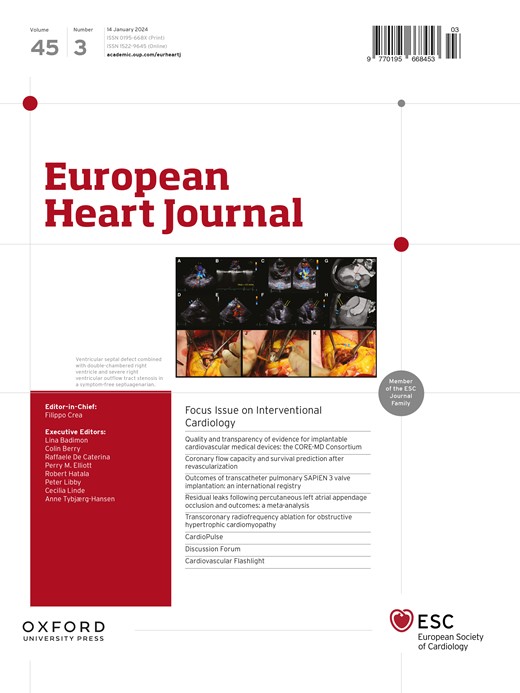Hypertrophic cardiomyopathy: changing the paradigm of exercise prescription and competitive sport participation.
IF 35.6
1区 医学
Q1 CARDIAC & CARDIOVASCULAR SYSTEMS
引用次数: 0
Abstract
Historically, individuals with hypertrophic cardiomyopathy (HCM) have been systematically excluded from vigorous exercise and competitive sports due to concerns about increased sudden cardiac death (SCD) risk. However, emerging evidence has challenged this paradigm. Observational studies and randomized trials demonstrate improvements in functional capacity, quality of life, and overall cardiovascular and psychological health with tailored exercise in HCM populations -including competitive sports in low-risk individuals-in the absence of safety signals. Low-risk individuals are defined by the lack of well-established adverse features such as a high European Society of Cardiology HCM SCD risk score, exercise-induced syncope, severe left ventricular outflow tract obstruction and ventricular arrhythmias. The concept that this low-risk subset can safely engage in competitive sports is becoming widely accepted internationally, although local differences exist in terms of regulations and clinical approaches. For individuals who do not meet low-risk criteria, evidence is more limited. Nevertheless, participation in competitive sports may still be considered on an individual basis, after appropriate risk mitigation strategies (including treatment of obstruction and ICD implantation when indicated). A contemporary approach to HCM should be based on individualized, goal-oriented exercise prescription, supported by multidisciplinary counselling and shared decision-making, recognizing the importance of aligning medical recommendations with individual safety, values, goals, and quality of life. In this review, we critically appraise the emerging evidence surrounding vigorous exercise and competitive sports in HCM and explore how novel data are reshaping clinical practice and international guidelines, setting the stage for a paradigm in the field.肥厚性心肌病:改变运动处方和竞技体育参与的范式。
从历史上看,肥厚性心肌病(HCM)患者由于担心心源性猝死(SCD)风险增加而被系统地排除在剧烈运动和竞技体育之外。然而,新出现的证据对这种范式提出了挑战。观察性研究和随机试验表明,在没有安全信号的情况下,HCM人群通过量身定制的运动(包括低风险个体的竞技体育)可改善功能能力、生活质量以及整体心血管和心理健康。低风险个体被定义为缺乏明确的不良特征,如欧洲心脏病学会HCM SCD风险评分高,运动诱发的晕厥,严重的左心室流出道阻塞和室性心律失常。尽管在法规和临床方法方面存在地方差异,但这一低风险人群可以安全地参加竞技体育的概念正在国际上被广泛接受。对于不符合低风险标准的个体,证据更为有限。尽管如此,在采取适当的风险缓解策略(包括治疗梗阻和在需要时植入ICD)之后,仍可考虑个人参加竞技体育。HCM的现代治疗方法应该基于个体化的、目标导向的运动处方,在多学科咨询和共同决策的支持下,认识到将医疗建议与个人安全、价值观、目标和生活质量相结合的重要性。在这篇综述中,我们批判性地评估了围绕剧烈运动和竞技体育在HCM中的新证据,并探讨了新数据如何重塑临床实践和国际指南,为该领域的范式奠定了基础。
本文章由计算机程序翻译,如有差异,请以英文原文为准。
求助全文
约1分钟内获得全文
求助全文
来源期刊

European Heart Journal
医学-心血管系统
CiteScore
39.30
自引率
6.90%
发文量
3942
审稿时长
1 months
期刊介绍:
The European Heart Journal is a renowned international journal that focuses on cardiovascular medicine. It is published weekly and is the official journal of the European Society of Cardiology. This peer-reviewed journal is committed to publishing high-quality clinical and scientific material pertaining to all aspects of cardiovascular medicine. It covers a diverse range of topics including research findings, technical evaluations, and reviews. Moreover, the journal serves as a platform for the exchange of information and discussions on various aspects of cardiovascular medicine, including educational matters.
In addition to original papers on cardiovascular medicine and surgery, the European Heart Journal also presents reviews, clinical perspectives, ESC Guidelines, and editorial articles that highlight recent advancements in cardiology. Additionally, the journal actively encourages readers to share their thoughts and opinions through correspondence.
 求助内容:
求助内容: 应助结果提醒方式:
应助结果提醒方式:


